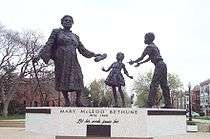Lincoln Park (Washington, D.C.)
| Lincoln Park | |
|---|---|
|
Lincoln Park looking west from Mary McLeod Bethune Statue | |
 Location within Washington, D.C. | |
| Location | Washington, D.C. |
| Coordinates | 38°53′23″N 76°59′23″W / 38.889722°N 76.989722°WCoordinates: 38°53′23″N 76°59′23″W / 38.889722°N 76.989722°W |
| Created | 1867 |
| Website |
www |

Lincoln Park is an urban park located in the Capitol Hill neighborhood of Washington, D.C. The largest Capitol Hill Park, Pierre (Peter) Charles L'Enfant included it in his original 1791 plan for the District of Columbia, intending it for public use (see: L'Enfant Plan).[1] L'Enfant planned it to be the point from which all distances in North America would be measured, although it was not ultimately utilized for this purpose.[2] It was known historically as Lincoln Square.
Situated one mile directly east of the United States Capitol, Lincoln Park is maintained by the National Park Service. The park is bounded by 11th Street NE and SE on the west, 13th Street NE and SE on the east, East Capitol Street NE on the North, and East Capitol Street SE on the south. It is four blocks northeast of Eastern Market, Washington, D.C.
The eastern end of the park includes two separate, enclosed play areas for young children. The grassy perimeter and central turf area are popular with neighborhood dogs and their owners.
History
Lincoln Park was initially used as a dump.[3] During the Civil War, it was the site of Lincoln Hospital and was among the places visited by Walt Whitman, who was visiting injured soldiers. In 1867, Congress authorized the grounds to be called Lincoln Square as a memorial to the former president; it was the first public site to bear his name.[3]
Statues
The park features two important sculptures: Thomas Ball's 1876 Freedman's Memorial to Abraham Lincoln (Emancipation Monument), one of the first memorials in Washington honoring Abraham Lincoln,[4] and Robert Berks' 1974 Mary McLeod Bethune Memorial.
References
- ↑ "Lincoln Park". Capitol Hill Parks | District of Columbia. National Park Service. Retrieved 11 March 2013.
- ↑ Pohl, Robert (November 9, 2009). "Lost Capitol Hill: The Zero Milestone". The Hill is Home. Retrieved 11 March 2013.
- 1 2 "Lincoln Park". Washington, D.C.: A National Register of Historic Places Travel Itinerary. National Park Service. Retrieved 11 March 2013.
- ↑ Kirk Savage (1999). Standing Soldiers, Kneeling Slaves: Race, War, and Monument in Nineteenth-Century America. Princeton University Press. pp. 11–. ISBN 978-0-691-00947-6. Retrieved 11 March 2013.